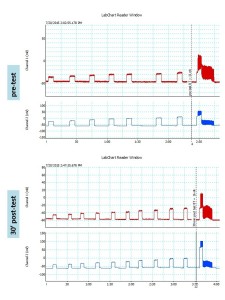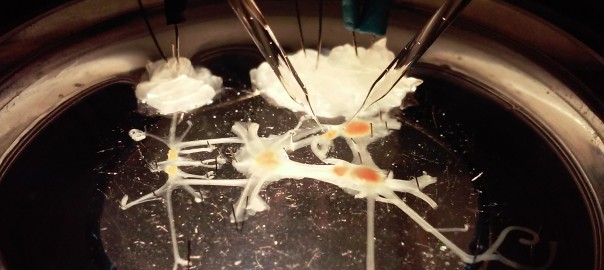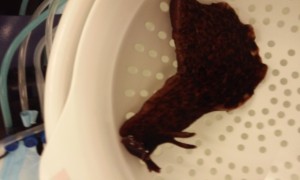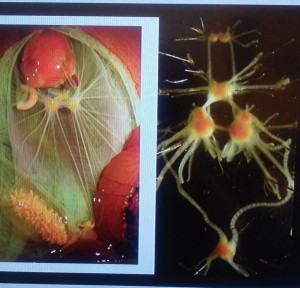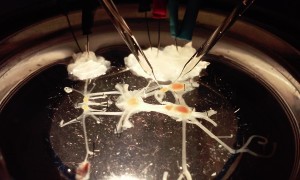
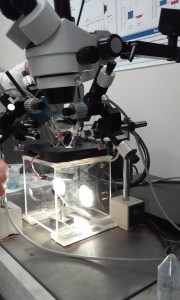

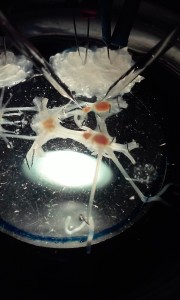
This lab included many great experiments from brain surgery to dissections and microscope use. I learned so much in this lab it is nearly impossible to explain it all in one page. This page will highlight one of the many experiments being performed in Dr. Mozzachiodi’s Neuro lab.
Who We Are
What We Did
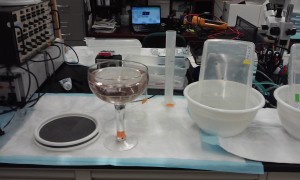

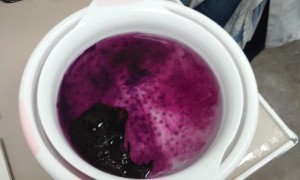
 In this lab we performed many experiments which were geared towards learning more about how aplysia remember. One memorable experiment, the methylene blue experiment, involved four aplysia, four large glass dishes, a stop watch, a lap counter, seaweed extract, methylene blue, and a mixture of a vessel. This experiment consisted of three tests to count how many times an aplysia bit within a five minute window of time. The first test, the pretest, is done at the beginning of the experiment. Each snail is placed into a artificial seawater and seaweed extract bath, when the aplysia attaches to the side of the glass bowl the number of bites are recorded. We record the time at which the aplysia took its first bite after attachment as well. When each of the four animals has gone through the experiment, they are injected with a solution. Two of the animals will be injected with a vessel mixture of artificial seawater and de-ionized water. The other two animals will be injected with a mixture of methylene blue and de-ionized water. The vessel injection is needed to insure the only variable different among the animals is the methylene blue or seawater; this way we can be sure as to what is actually effecting the behavior of the animals. Next after the allotted amount of time, the animals go to training. In training the one of each of the two sets of animals will be trained with a low voltage shock which serves the purpose of startling the animal. When an animal is startled it will ink. The motions taken to startle the animal will be done to all animals even those not being trained. This consistency is needed to insure the motion of changing the water does not affect the behavior of the animal. Twenty minutes has passed; the animals are then placed in the glass dish again for the twenty minute post-test. The results are recorded and the animals are placed back in their designated container to wait for the two hour post-test. The two hour post test is performed just as the pre-test and the twenty minute post-test. When the experiment is complete the vessel animals go back into the tank and the methylane blue animals are then dissected to insure the methylene blue was evenly distributed in the animal and no vital organs were punctured during injection.
In this lab we performed many experiments which were geared towards learning more about how aplysia remember. One memorable experiment, the methylene blue experiment, involved four aplysia, four large glass dishes, a stop watch, a lap counter, seaweed extract, methylene blue, and a mixture of a vessel. This experiment consisted of three tests to count how many times an aplysia bit within a five minute window of time. The first test, the pretest, is done at the beginning of the experiment. Each snail is placed into a artificial seawater and seaweed extract bath, when the aplysia attaches to the side of the glass bowl the number of bites are recorded. We record the time at which the aplysia took its first bite after attachment as well. When each of the four animals has gone through the experiment, they are injected with a solution. Two of the animals will be injected with a vessel mixture of artificial seawater and de-ionized water. The other two animals will be injected with a mixture of methylene blue and de-ionized water. The vessel injection is needed to insure the only variable different among the animals is the methylene blue or seawater; this way we can be sure as to what is actually effecting the behavior of the animals. Next after the allotted amount of time, the animals go to training. In training the one of each of the two sets of animals will be trained with a low voltage shock which serves the purpose of startling the animal. When an animal is startled it will ink. The motions taken to startle the animal will be done to all animals even those not being trained. This consistency is needed to insure the motion of changing the water does not affect the behavior of the animal. Twenty minutes has passed; the animals are then placed in the glass dish again for the twenty minute post-test. The results are recorded and the animals are placed back in their designated container to wait for the two hour post-test. The two hour post test is performed just as the pre-test and the twenty minute post-test. When the experiment is complete the vessel animals go back into the tank and the methylane blue animals are then dissected to insure the methylene blue was evenly distributed in the animal and no vital organs were punctured during injection.
What We Learned
The methylene blue does not have a great effect on the training of aplysia. The methylene blue has been proven before to have an effect to block the learning of the animals, but in this experiment design the only way to make this happen would be to give the animals a higher dose of methylene blue. The problem with a higher dose is there would not be any biting from the animals at all so there would be no way of telling if the training affected the animals. More of the methylene blue experiments must be done in order to create a large enough sample size of data to prevent other scientists from doubting the findings.
Questions We Have
Connections to Teaching
This experiment involved weighing, measuring liquids, using stop watches and observing results. There are both math and science applications to be used from this experiment. Although this experiment did not give the desired results, it is a great way to show students in the real world, science involves trial and error and that solutions can be found by altering one variable in an experiment. Although students may not be able to have access to aplysia the model of the experiment involving pre and post tests as well as the use of the equipment can be used by students in both math and science. Displaying results after many trials can be applied in a lesson from the experiment as well.
Grade 7 Science TEKS
(E) Organisms and environments.
(i) Students will understand the relationship between living organisms and their environment. Different environments support different living organisms that are adapted to that region of Earth. Organisms are living systems that maintain a steady state with that environment and whose balance may be disrupted by internal and external stimuli. External stimuli include human activity or the environment. Successful organisms can reestablish a balance through different processes such as a feedback mechanism. Ecological succession can be seen on a broad or small scale.
Grade 7 Math TEKS
(12) Measurement and data. The student applies mathematical process standards to use numerical or graphical representations to analyze problems. The student is expected to:
(A) represent numeric data graphically, including dot plots, stem-and-leaf plots, histograms, and box plots;
(B) use the graphical representation of numeric data to describe the center, spread, and shape of the data distribution;
